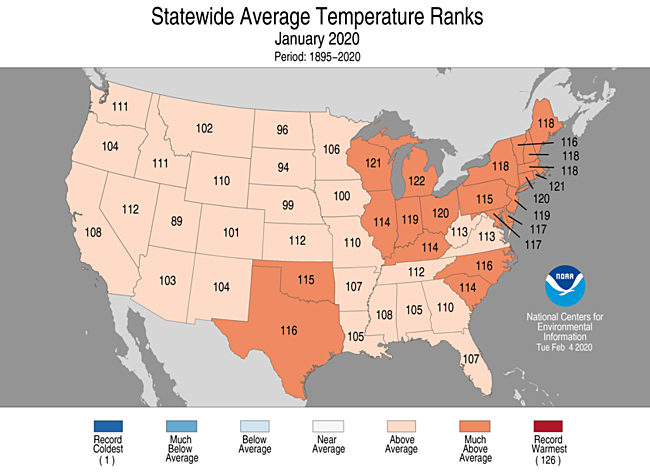Thursday February 6th… Dear Diary. The main purpose of this ongoing blog will be to track United States extreme or record temperatures related to climate change. Any reports I see of ETs will be listed below the main topic of the day. I’ll refer to extreme or record temperatures as ETs (not extraterrestrials).😉
Main Topic: Early February Record Scoreboard Update and Climatological Review
Dear Diary. The signs of global warming are everywhere as of early 2020. In the United States just a few tenths of a degree of warming in association with temperature averages have resulted in a March type storm bringing severe weather with flooding to the Southeast, and practically no snow for the Megalopolis area in the Northeast this winter. In fact:
Now, snow isn’t melting everywhere, and the latest winter storm has put down a good coating of the white stuff from the southern Plains into the Midwest, but the public is beginning to take notice of the overall mild weather: I was in short sleaves yesterday before TWC’s winter storm Kade dumped several inches of rain on Atlanta today, on Thursday. Such March like weather occurring in early February was nonexistent when I was growing up in the 1970s here in Atlanta.

Anyway, it’s that time of the month when NCEI has completed their assessment for the prior month, so I’m trotting out record scoreboard updates.
Here on this site we present monthly summaries near the 6th of each month, and each is available if you want to go back through my Extreme Temperature Diary archive.
Oh, and by the way:
What a way for the new decade to begin…unfortunately very warm by climatological standards. January 2020 got ranked by the National Center for Environmental Information as a well above average January, temperature wise, for the lower 48 states, coming in as 5th warmest or 122nd coldest since records began being kept in 1895:
https://www.ncdc.noaa.gov/cag/national/rankings/110/tavg/202001
Here we see rankings for each state in the contiguous United States:

Just like for December we see a disturbing pattern of above average temperatures from coast to coast. The core of the most anomalous warmth was from the Midwest into the Northeast. Not one state was colored white or near average.
Here are my two U.S. Daily Record Scoreboards updated through 2/6/2020 (data compiled from the following NCEI site):
https://www.ncdc.noaa.gov/cdo-web/datatools/records


DHMX= Daily High Max Reports. DLMN= Daily Low Min Reports. DHMN= Daily High Min Reports. DLMX=Daily Low Max Reports.
For these data sets all monthly ratios of > 10 to 1 DHMX to DLMN or > 10 to 1 DLMN to DHMX are in bold type. The rankings are for the lower 48 states with the warmest ranking since 1895 of average temperatures being 125 and 1 being the coldest as of 2020. Blue colors represent cold months and red warm. Those months and years with counts close to a 1 to 1 ratio of highs to lows are colored black. Boldly colored months, such as May 2018, have ratios of more than 10 to 1 daily record highs to lows or lows to highs, and are either historically hot or cold, most of which have made news.
January 2020 had over a 15-1 ratio of record DHMX to DLMN individual record counts, so the color I used for this month was bold red on the top chart.
January 2020 had over an 11-1 ratio of record DHMN to DLMX individual record counts, so the color I used for this month was bold red on the bottom chart.
Due to climate change we will see less blue colors on these Record Scoreboards with time, and in the United States January 2020 was no exception.
Also, looking at the record scoreboards, I wonder how long a cooling trend will last going into the 2020s, which we have seen since 2017? Certainly there has been a big turnaround in early 2020.
As stated, the ranking for January 2020 was 122, which was colored red. I color rankings +10 or -10 from the average ranking of 63 black indicating that these are near average temperature wise.
February 2020 has gotten off to a well above average temperature start looking at current record tallies, which continue to be over 10-1. We will see if we get back to back bold red months to start out 2020.
If you add up all the current tallies of daily warm records VS. cold you get a whopping 8255 to 1001, or a near 8-1 ratio for December through January. No wonder that we just saw the warmest start to winter in the U.S. in history.
Here is more January 2020 climatology:
Please consider donating through the Paypal widget on this site. I need everyone’s support to continue my work, especially that of processing NCEI record count data for scientific research.
Here is some more weather and climate news from Thursday:
(As usual, this will be a fluid post in which more information gets added during the day as it crosses my radar, crediting all who have put it on-line. Items will be archived on this site for posterity.)
(If you like these posts and my work please contribute via the PayPal widget, which has recently been added to this site. Thanks in advance for any support.)
Guy Walton- “The Climate Guy”